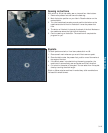
Sewing
2. Attach the buttonhole foot and pull it backward as far as the second
red mark. Before starting to sew, press the “needle down” button.
3. Sew the right side of the buttonhole.
4. After the machine sews the fi rst few stitches of the curved end pull
the gimp thread down from the clamp with a straight pin.
Note: The presser foot must not be raised from the fabric!
5. Pull the gimp thread on the left towards the rear until the loop is
just in front of the needle. Carefully sew the curve, guiding the
gimp thread under the stitching.
6. After sewing the curve, hold the gimp thread slightly taut and
fi nish sewing the buttonhole.
7. Thread the gimp threads into a needle and pull them to the wrong
side of the garment. Tie the gimp threads and cut off the excess
thread.
The round buttonhole with gimp thread is sewn in the same way.
Note: This buttonhole is particularly attractive when sewn with a heavier-weight thread.
Buttonhole tips
Buttonholes that are to be sewn very close to a reinforced edge, may
sometimes not feed optimally with the buttonhole foot because of the
bulk at the edge of the fabric. In this case, use presser foot 1A with the
Integrated Dual Feed engaged.
Fabrics that shift or stretch easily should be reinforced with water-
soluble or lightweight stabilizer.
Buttonholes are particularly stable and durable if a gimp cord is
inserted while sewing (see " Buttonholes, with gimp cord").
Linen buttonholes are particularly attractive if you use a heavier-
weight thread through a topstitch needle.
Buttonholes are normally selected a little larger than the button
diameter. It is important to always sew a test buttonhole on the same
fabric/stabilizer as your project.
Cut open all buttonholes carefully. Open the curve of the keyhole
buttonhole with a belt punch or awl.
3:18


















